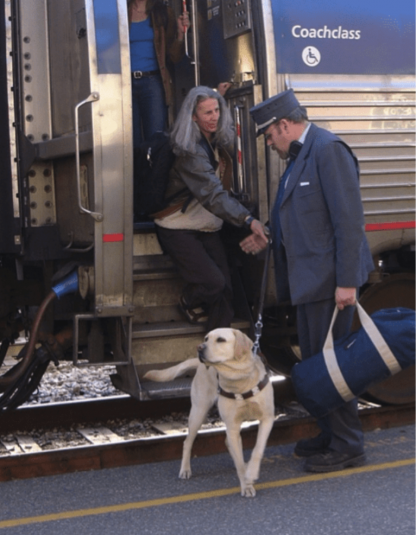Happening Now
Disability Steps Improve Access For Everyone
July 18, 2025
by Jim Mathews / President & CEO
Sometimes in this job, I have to say things that people don’t like. More often than not, it’s saying things to Amtrak that they don’t like. Other times, it’s saying things to members of Congress that they don’t like. And every once in a while I run into that uncomfortable moment when I even have to say something to a small handful of donors, supporters, or dues-paying Association members that THEY don’t like.
This is one of those times. And I'm sure it really IS just a small handful. But I can't stay silent.
Earlier this week, I reported to all of you about efforts by the Amtrak Office of Inspector General to make sure Amtrak – a public, taxpayer-supported entity – is the doing the best it practically can do for the disabled passengers it serves. To its great credit, Amtrak responded thoughtfully to the auditors’ findings and recommendations, and is taking steps to address the issues the auditors raised.
As is our regular practice, we republished our article to our social media channels. Although many of the comments were ordinary, others were appalling.
Like this one: “Regular citizens first.”
That, especially, really shocked me. “Regular citizens.” One in seven Americans has a disability. And because flying and driving can be particularly difficult or impossible for them, disabled passengers make up an outsize fraction of Amtrak’s ridership, a lot more than one in seven Amtrak riders. Among our own members, donors, and supporters, that share is likely higher still.
They’re citizens. They’re taxpayers. They paid their fares. They’re every bit as “regular” as you are.
And, more precisely, those kinds of comments made it crystal-clear to me that those commenters didn’t even read the article. Like Pavlov’s dogs, they saw the word “disabilities” in the headline and started rage-typing at their keyboards about wheelchairs. No reading required.
If they HAD read the article, they would have understood that much of what’s under discussion is not about aisle-width, but instead is about making the Amtrak app work better for people who are blind, or audiovisual messaging in stations, or interactions with Amtrak employees – 39 percent of the complaints the Inspector General reviewed were about poor assistance with getting on or off trains at stations.

It's also about legal responsibility. The Americans with Disabilities Act was signed in 1990, and it’s the law. For many reasons – some extremely reasonable and some baffling – Amtrak has struggled meeting some of those requirements, and signed a settlement with the Justice Department in 2020 promising it would take particular steps on long-standing issues. Amtrak has a legal obligation to do this work. It's the law.
Some of the comments we’ve deleted for sheer offensiveness. Others remain. But I’m personally very disappointed that people can somehow be offended by improving signage, broadening food options, addressing narrow stairways, making the booking process easier, or simply training certain employees to be more courteous and helpful.
Is there a thoughtful, nuanced conversation to be had about the physics and geometry of getting wheelchairs on to trains without sacrificing seats? Yes, and many railcar builders have actually come up with decent solutions. Physical accessibility for those with mobility issues is genuinely important, and extends well beyond just the footprint of a wheelchair. A lot of improvements could be made that would benefit every single traveler, and not just the person in a wheelchair. It doesn’t have to be about “us” versus “them.”
For example, if you've put in a ramp to comply with ADA for wheelchairs, you've also made a really great way to roll your rollaboard carry-on suitcase. If you've made a wide aisle, you haven't just made it better for a wheelchair but you've also made it easier for larger passengers to pass through the aisle. Americans are among the most obese in the world. So that's actually important. If you've made the Amtrak app easier to navigate, you've solved a problem for just about everyone and not just those with visual impairments.
Yes, those commenters are entitled to their opinion. But you know what? So am I. Clever and thoughtful designs can ensure that disabled access does not need to mean taking something away from other passengers. That’s something we work hard on already, and we’ll keep doing that. But I’m also going to continue working hard to make sure that train travel – Amtrak, Brightline, commuters, subways, light rail, or anything else – is open to anyone. It's just the right thing to do.
And here's something that I'm NOT going to do. I'm not going to tolerate belittling people in our coalition who are blind, deaf, have mobility issues, sensory issues, food allergies, or any other challenge. We're all in this together...or at least, we should be.
"The National Association of Railroad Passengers has done yeoman work over the years and in fact if it weren’t for NARP, I'd be surprised if Amtrak were still in possession of as a large a network as they have. So they've done good work, they're very good on the factual case."
Robert Gallamore, Director of Transportation Center at Northwestern University and former Federal Railroad Administration official, Director of Transportation Center at Northwestern University
November 17, 2005, on The Leonard Lopate Show (with guest host Chris Bannon), WNYC New York.
Comments